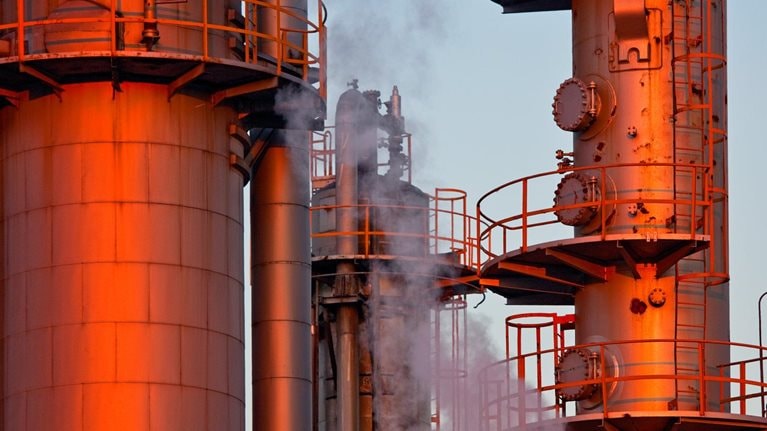The drive for sustainability is revolutionizing the chemical industry. Our research shows that as of early 2023, 66 percent of the largest chemical end users in Europe—including players in the automotive, food, and personal-care industries—had committed to reducing greenhouse-gas (GHG) emissions by 2030, and 37 percent have pledged net-zero targets by 2050. In Germany, Europe’s largest economy, the industry aims to reduce CO2 emissions by approximately 35 percent by 2030.1
Manufacturing chemicals is energy intensive, with some critical processes producing large amounts of CO2 as a by-product. And because many chemicals are made from carbon, products can release CO2 or methane if they are incinerated or decomposed at the end of their lives as part of waste management. These factors make it particularly difficult for the chemical industry to cut emissions to reach net-zero emissions. Although there are several steps to create greener solutions—such as reducing the footprint of operations through energy efficiency and green energy, capturing and storing CO2, and switching to advanced recycling to avoid incineration2—these measures alone will not get the industry to net zero.
One solution to close the gap is the use of sustainable feedstocks, such as biomass and CO2. However, this approach is not without challenges, particularly when it comes to matching the right feedstocks and conversion technologies with the right products in the right regions of the world. In response, companies will need to develop evaluation criteria around feedstock availability, sustainability performance, technology maturity, and economics.
This article aims to provide an overview of sustainable feedstocks in chemicals. Our findings show that players can navigate uncertainty by pursuing long-term supply and offtake agreements, focusing investments where economics are likely to be supportive, and helping ensure their suppliers use efficient and sustainable (regenerative) farming practices.
Recarbonization through feedstock evolution is necessary
Because the chemical industry makes products used in other industries, it plays a critical role in industry as a whole.3 End users in chemicals are extensive; for example, they include the automotive and construction industries, two of the highest emitters of global GHG emissions.
Our research shows that two broad moves can help address approximately one-third of the chemical industry’s total GHG emissions by 2030 (Exhibit 1). What’s more, both moves involve low CO2-equivalent (CO2e) abatement costs, have no substantial downsides, and are widely accepted by the public and regulators.

- Increasing energy efficiency and use of green energy. Powering operations with green energy and increasing operations’ energy efficiency via measures such as heat integration and green-electricity procurement can reduce the total emissions of the chemical industry by as much as one-third by 2030 and more in subsequent years (via the electrification of crackers, which are currently the largest emitter in chemicals).4 What is more, this move can be achieved via measures that cost less than €100 per ton of CO2 saved.5 Therefore, nearly every chemical player should prioritize increasing energy efficiency and using green energy.
- Recycling. Various technologies for different types of household and industrial waste (such as mechanical and chemical recycling for separated plastics and textile fibers, and gasification for otherwise nonrecyclable organic waste) are proven and can be deployed at a large scale. Because these technologies avoid the incineration of waste and create circularity for carbon inherent in the recycled materials (thereby avoiding the emissions for producing hydrocarbons), they have the potential to reduce the chemical industry’s total emissions by as much as 5 percent by 2030 and considerably more afterward. Ultimately, waste incineration and landfills could be replaced completely.6 Although recycling “low quality” waste (which refers to mixed or otherwise nonrecyclable organic waste) inherently leads to some CO2 generation, modern technologies yield highly concentrated CO2 that can be used as a feedstock for fuels, chemicals, and agriculture.7 However, clear regulatory positions on some recycling outputs, such as hydrogen from waste gasification, sometimes lag behind standards, are unclear, or require puzzling together several related regulations to understand impacts. This is an impediment to widespread adoption.
Nevertheless, as attractive and important as these measures are, they are not sufficient to reach net-zero emissions in chemicals or to offset emissions from currently practiced end-of-life activities, such as waste incineration.
Furthermore, our research shows that those that adopt only these options will often still depend on others to reduce their own emissions, particularly upstream players. This consideration is relevant because many upstream players aim for large-scale reductions only by 2040 or 2050. For chemical companies that serve markets in which customers have committed to aggressive decarbonization targets (such as automotive and consumer goods), additional action is required to meet customers’ near-term demand for low- or zero-CO2e options.
Two paths to reduce emissions include capturing and sequestering CO2 emissions at the source via carbon capture and storage (CCS), and switching to non–fossil fuel feedstocks, such as biomass or CO2, which can be converted into chemical feedstocks and intermediates.8 For major sources of CO2 emissions, such as large crackers, CCS is often one of the clearest and most economical ways to substantially cut emissions (for crackers, the only alternative is electrification). According to our analysis, however, CCS alone addresses only 30 to 50 percent of total emissions.
That said, CCS cannot address end-of-life emissions in chemicals, which could affect players that want or need to offer net-zero products. In addition, CCS is unsuitable for smaller sources of emissions and depends on access to CO2 transportation and storage infrastructure, which is frequently lacking. This means that although CCS could be an important technology to bend the overall industry emissions curve, players that want to quickly move to net zero will need additional technologies.
Chemical companies looking to accelerate their emissions reductions further can pursue new feedstock routes, either via plant biomass or mechanical–chemical CO2 capture and conversion. Both reduce emissions by starting from carbon provided by CO2 in the atmosphere instead of fossil-based sources. For that reason, we call these “recarbonization” practices. And chemical companies that move early will likely be able to realize price premiums driven by rapidly accelerating demand and lead times to build supply.
Sustainable feedstocks: Biomass and CO2-to-X
Two processes can be used to extract CO2 from the atmosphere and turn it into chemical feedstocks: biomass and CO2-to-X. The latter is a term that refers to CO2 conversion into products, such as methanol and ethanol, that can be used to synthesize a large number of chemical products.
We have modeled the costs and sustainability of a variety of routes to various important chemicals. One example is ethylene, which is the industry’s highest-volume molecule (Exhibit 2).

Ethylene is used as an early intermediate for various end products, such as packaging plastics. The results are typical also for many other chemicals: First, fossil naphtha tends to be cheaper with today’s technologies, but the lowest-cost execution of sustainable routes could already reach fossil naphtha’s costs in a subset of scenarios. Second, recycling can combine relatively low costs with good abatement because end-of-life incineration can be avoided. Third, both costs and abatement potential vary not just between routes but also very strongly within. The reason is that different locations and times have very different prices for key inputs. For example, CO2-to-X costs typically depend on electricity prices, which differ strongly among regions and countries. The same is true for emissions intensity: depending on the source of electricity, it can be anywhere from zero to large. For such reasons, different routes will likely be built in different places to take advantage of input cost advantages or other cost factors from favorable regulation.
Where it can be sourced sustainably, biomass from sugar-yielding plants is promising in the short term, possibly supplemented by wood biomass as another sugar source, before moving to CO2-to-X over the medium to long term (Exhibit 3). As chemical companies progress along this route, they can pursue available conversion technologies while investing in developing increasingly efficient, next-generation processes.

Harnessing the power of plants: Biomass
Plants take in atmospheric CO2 as they photosynthesize, enabling them to grow and yield sugar (C6 sugars in easily accessible forms including starch), oil, and woody biomass (lignin and C6 and C5 sugars in harder to access polymeric forms: cellulose and hemicellulose). Each of these can be converted via various means into useful chemicals.
Sugar is the easiest starting point for conversion into biofuels and other valuable chemicals. It also often has the lowest cost of production. Although biotech conversion processes unlock entirely new molecules inaccessible with traditional chemistry,9 today’s sugar conversion technologies cover only a subset of the industry’s target molecules. Most technologies focus on fermenting sugar to create organic acids (such as lactic acid, which can be turned into polylactic acid polymer) or ethanol to produce ethylene derivatives. These derivatives amount to approximately one-quarter of the industry’s primary petrochemical output by volume. Although this direct scope of production misses several target molecules, ethanol and ethylene derivatives can be processed to other chemicals (albeit at substantial added costs), making them a potential future platform for a wider range of products.
Another factor to consider is the emissions intensity of ethanol production from sugar, which is directly affected by fermentation efficiency. This is because a significant amount of carbon (and thus mass) is lost in the fermentation of sugar to ethanol, increasing the ratio of emissions from upstream agriculture to the final product (as the emissions from the total ingoing feedstock are allocated to fewer tons of the final product). However, there is potential for emerging “cell free” conversion technologies. Switching from fermentation to these technologies could boost efficiency for a substantial set of molecules by as much as 50 percent, thereby reducing the required amount of feedstock input.
Plant-derived oils cover all target molecules, and the relevant conversion technology is well established because the oil can largely substitute fossil oil inputs directly, reusing the established petrochemical production assets. However, plant-derived oils are costlier than sugar. Waste oils (such as used cooking oils) are in short supply and face competition from fuel production. Also, dedicated production of oil crops for chemicals, such as palm oil, may raise concerns about agricultural competition with food supply, land-use change, and biodiversity. For these reasons, plant-derived oils should be considered an interim solution.10
Wood biomass is a more complex starting point for biochemicals. Options include gasification to create methanol, hydrothermal treatment to create oil-like outputs, or fractionation into its constituents (such as lignin and sugars) and fermentation of the sugars to create, for example, ethanol. With relatively large conversion losses or high-complexity processes, these are generally costlier than starting directly from sugars. However, sustainable wood biomass is currently available at lower cost and in larger quantities—for example, as a by-product of pulping (primarily for making paper but also for fibers and other products). If uses can be found for its large-volume constituents that currently mainly have low-value outlets, primarily lignin, wood biomass could become attractive at large scale, both economically and regarding sustainability. In addition, there is strong pressure to use “second generation” biomass, which refers to nonfood biomass. Over time, thus, the higher cost of using wood biomass could be economical, especially for companies in regions with stricter rules about which feedstock is considered “sustainable.”
Long-term sustainability and scalability: CO2-to-X
CO2 can be captured—from bioethanol production’s emissions, for example—and converted into chemicals using man-made synthetic processes powered by renewable energy. This process, known as CO2-to-chemicals conversion, has a higher output potential than biomass per unit of land, and therefore stands a significant chance of displacing biomass over the long term.
That said, CO2-to-chemicals conversion is energy intensive. Therefore, it is currently practical only in locations with substantial subsidies (such as the United States, which has the Inflation Reduction Act), abundant renewable energy (such as the US Midwest and Texas), and high-purity CO2. Bio-based feedstocks used for chemical or fuel production via fermentation are a good source for CO2, because their CO2 emissions have high levels of purity and sustainability profiles, given their biogenic origins. However, CO2-to-chemicals conversion technologies are currently limited in their output, so chemical players may want to pursue R&D over the long term to make CO2-to-chemicals efficient for target molecules.
Mitigating uncertainty with improved farming practices and long-term supply and price agreements
Although each sustainable feedstock and related conversion technology has its pros and cons, the applicability for any chemical player willing to decarbonize also depends on the player’s legacy production setup, position in the value chain, and potential economics. Hence, each sustainable feedstock option needs a case-by-case consideration.
As noted, second-generation biomass is that which cannot be used as food for humans, such as food crop waste and wood chips. Using biomass that would have otherwise been wasted is more sustainable than using first-generation biomass and can alleviate the concern that using too much food crop for nonfood uses (such as for fuel or chemicals) will incur more direct GHG emissions and induce more land to be converted to cropland (indirect land-use change). For these reasons, second-generation biomass may become more important in the years to come.
However, the economics of second-generation feedstock are often difficult, the required technologies and logistics are still emerging, and the use of first-generation biomass continues to be permitted in multiple countries, including the United States. No matter which type of biomass is chosen, the following two practices can help companies ensure it is sustainable and avoid paying elevated spot prices:
-
Engage suppliers to ensure good farming practices. This is particularly relevant for first-generation biomass. Well-managed crop agriculture can sequester carbon in the soil, whereas poorly managed agriculture can be a net emitter (Exhibit 4). Because today’s markets do not strongly differentiate between these management types, chemical players using biomass can take it upon themselves to engage with suppliers. This entails closely monitoring whether cultivation is deemed to cause direct or indirect land-use change, especially the conversion of forest to cropland.
Because of land-use considerations, the productivity of crop production is also critical; farmers who use superior plant genetics, apply inputs (fertilizer, biostimulants, and pesticides) in the most sustainable manner, and take advantage of “second seasons” (growing cover crops during winter) will generally have feedstocks with better sustainability profiles. This potential for further biomass production per hectare through intensification is not well appreciated outside of the agriculture sector. To put this in perspective, the average corn yield per acre in the United States—which is not even the top country by average yield—is about 90 percent higher than the global average.11 And in the United States, the record yield is more than three times the US average.12
- Enter into long-term supply agreements. Sustainable biomass is in short supply. Our estimates show that future supply will fall well below potential demand from chemicals and other sectors, such as fuels (for automotive, aviation, and shipping) or energy, which are competing for supply. In fact, 2050 global biomass demand from these sectors could outgrow sustainable supply two times over.13 As demand continues to grow, so does the risk of price increases and supply shortages.

One way to safely avoid these risks is to enter long-term supply and offtake agreements, which can help mitigate market outpricing risks (from petrochemicals or competing sustainable feedstock-based chemicals). Other value chains—such as those for steel,14 sustainable aviation fuels,15 battery materials, and even some chemicals (such as recycling polyethylene terephthalate)—also show that large-scale offtake agreements are possible. And they have the further benefit of sometimes becoming “lighthouses” that show what is possible and thus catalyze broader production of sustainable feedstock for the future.
To create competitive advantage, players can invest in novel technologies and feedstocks for which the economics are likely to become attractive—despite many uncertainties—and integrate themselves into the supply and customer sides through investments and long-term agreements. For chemical players, this approach has potential benefits for the environment and society. Making the right decisions today could mean the difference between staying competitive in the years to come or falling behind.


